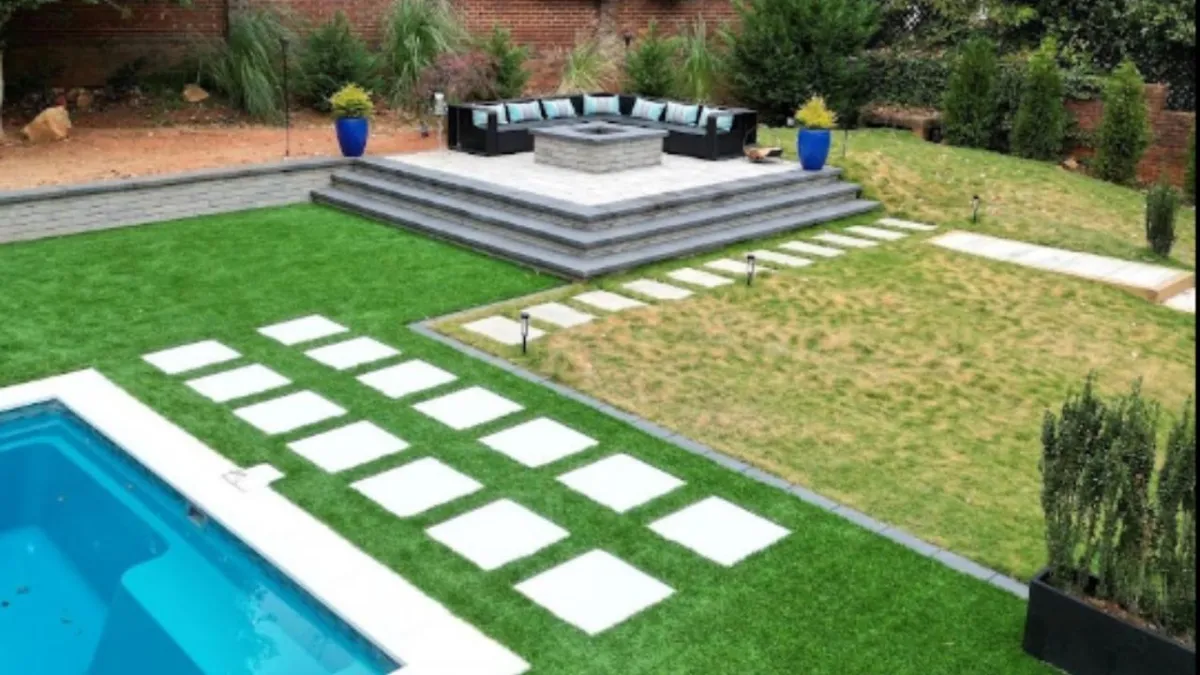Blogs

Factors to Consider When Landscaping Your Property: Pro Tips
When landscaping your property, consider the purpose of the space, local regulations, and your budget. Assess the size of your yard, soil type, and climate for suitable plant selection. Factor in maintenance needs, incorporate hardscaping elements, and plan for seasonal interest. Ensure the design complements your home’s style while considering water management and wildlife.
In this article, we’ll walk you through essential factors to consider when landscaping your property, from budgeting to climate and hardscaping. These expert tips will help guide your decision-making and ensure your project turns out exactly as you envision.
At Greystone Hardscapes, we specialize in transforming outdoor spaces in Charlotte, NC, and surrounding areas, offering everything from hardscaping to custom patios and fire pits. Let’s dive into the top factors to consider when landscaping your property.
Key Takeaways
Purpose and Use of Space: Identify how you want to use your outdoor space to guide your design.
Local Regulations: Research local zoning laws and HOA rules before starting your project.
Budgeting: Establish a budget that covers all aspects of your landscaping project.
Space and Size: Assess your yard’s size to determine which features fit best.
Soil Type and Condition: Test your soil to choose the best plants and soil amendments.
Climate and Plant Selection: Select plants suited for Charlotte’s climate and growing conditions.
Maintenance Requirements: Choose plants and features that match your desired maintenance level.
Hardscaping Elements: Incorporate hardscaping features to enhance the functionality and beauty of your space.
Seasonal Interest: Plan for a landscape that offers year-round appeal.
Aesthetic Appeal: Ensure your landscaping complements your home’s style and personal taste.
Key Factors to Consider When Landscaping Your Property
Purpose and Use of Space
The purpose of your outdoor space plays a crucial role in shaping the design. Whether it's for relaxation, entertainment, or play, identifying how you plan to use the area ensures the landscaping serves your needs.
Peaceful retreat for relaxation
Vibrant garden for nature lovers
Functional area for entertaining guests
Play area for kids or pets
Local Regulations
Before starting your landscaping project, it's important to understand any local zoning laws or homeowner association (HOA) guidelines that may affect your design. This helps avoid costly mistakes or delays.
Familiarize with zoning laws and HOA guidelines
Ensure features like fences or water elements meet standards
Obtain necessary permits for large installations
Budgeting
Landscaping projects vary greatly in cost. Setting a clear and realistic budget is essential to managing your project without unexpected expenses. It ensures you can allocate funds for key elements while maintaining control over costs.
Account for material, labor, and equipment costs
Prioritize key features like patios or fire pits
Adjust design elements based on available budget
Space and Size
The size of your yard significantly influences your landscaping design. Smaller yards may need creative solutions to avoid overcrowding, while larger spaces allow for more flexibility. Ensuring a proper layout is essential for balance and functionality.
Plan for creative solutions in smaller yards
Ensure a balanced layout in larger spaces
Create smooth transitions between patios, paths, and gardens
Soil Type and Condition
Soil quality is vital for plant health and growth. Testing your soil can provide insights into its nutrient levels and allow you to select the best plants and amendments for a thriving landscape.
Conduct a soil test to assess condition
Choose plants suited for soil type (clay, sandy, loamy)
Amend soil as necessary for healthy plant growth
Climate and Plant Selection
Choosing plants suited to your climate ensures long-term success. Charlotte, NC, with its USDA Plant Hardiness Zone 7b, requires plants that can thrive in this environment. Be mindful of sunlight levels to maximize plant health.
Select plants suited for USDA Zone 7b
Consider sunlight exposure: full sun, partial shade, full shade
Opt for native plants for low-maintenance growth
Maintenance Requirements
Ongoing maintenance is a key aspect of landscaping. Consider how much time you can dedicate to upkeep and select plants and features that align with your preferred level of care.
Choose low-maintenance plants for easy upkeep
Opt for hardscaping elements that require less care
Select plants with specific care needs for a more hands-on approach
Hardscaping Elements
Hardscaping elements such as patios, walkways, and retaining walls add structure and functionality. These features can enhance the beauty of your space while solving practical problems like drainage and erosion control.
Include elements like patios, walkways, and retaining walls
Improve drainage and prevent soil erosion
Create functional zones for specific purposes, such as outdoor kitchens
Seasonal Interest
Design your landscape with year-round appeal by incorporating a mix of evergreen plants and seasonal flowers. Adding lighting can highlight features and extend outdoor use, ensuring beauty no matter the season.
Use evergreen plants for winter interest
Plant seasonal flowers for spring and summer color
Add outdoor lighting for evening ambiance
Aesthetic Appeal
The design of your landscape should reflect your personal style while complementing the architecture of your home. A cohesive design that balances color, texture, and proportion will enhance both beauty and comfort.
Harmonize design with home’s architectural style
Focus on colors, textures, and proportions
Create a welcoming, comfortable outdoor space
Creating Sustainable Landscapes
Sustainability in landscaping involves making eco-friendly choices that conserve resources, support local wildlife, and reduce maintenance. By selecting the right plants and incorporating sustainable features, you can create a beautiful, eco-conscious outdoor space that benefits the environment.
Incorporate native plants that require less water and maintenance
Install rainwater collection systems for irrigation
Use permeable paving for walkways to reduce runoff
Support local wildlife by providing habitat through plant choices
Conserve resources with low-maintenance, drought-resistant plants
Hardscaping: The Art of Outdoor Design
Hardscaping is the backbone of outdoor design, adding structure and function to any landscape. It includes elements like patios, walkways, retaining walls, and outdoor kitchens. Hardscaping enhances both the beauty and utility of your outdoor space, creating well-defined areas for various uses.
Include patios, walkways, and retaining walls to add structure
Create outdoor kitchens for functional dining spaces
Use hardscaping to define areas for relaxation or entertaining
Improve drainage and prevent erosion with hardscape elements
Enhance the aesthetic appeal with carefully chosen materials
Landscaping for Outdoor Entertaining
Outdoor entertaining spaces are becoming a sought-after feature, extending living areas into the yard. Thoughtful design can turn your backyard into the perfect venue for family gatherings, BBQs, or dinner parties. Plan for ease of movement and comfort when entertaining guests outdoors.
Add an outdoor kitchen for cooking and dining
Include seating areas for comfortable socializing
Install a fire pit to extend outdoor time into the evening
Consider flow and accessibility for guests
Plan for lighting to create ambiance at night
Choosing the Right Plants for Your Landscape
Selecting the right plants is crucial to creating a thriving, aesthetically pleasing landscape. Factors such as soil type, climate, and sunlight exposure all influence plant choices. Native plants, which are well-suited to local conditions, can reduce maintenance and enhance your garden’s ecosystem.
Choose native plants for easier maintenance and better adaptation
Consider soil type (clay, sandy, loamy) and its impact on plant selection
Select plants based on sunlight exposure (full sun, partial shade, etc.)
Mix plant varieties for color, texture, and height variation
Plan for year-round visual appeal with seasonal flowers and evergreen plants
Maintaining Your Landscape Throughout the Year
Year-round landscape maintenance ensures your outdoor space remains vibrant and healthy. Each season brings unique tasks: planting in spring, regular watering in summer, and protecting plants in winter. Consistent care is essential to the long-term beauty and vitality of your landscape.
Spring: Plant new additions and refresh mulch
Summer: Water regularly and manage weeds
Fall: Plant perennials and prepare for colder weather
Winter: Protect plants from frost and harsh conditions
Perform routine maintenance tasks like pruning and fertilizing
Frequently Asked Questions About Landscaping
What’s the best time to start landscaping? The best time to start landscaping in Charlotte is typically in early spring or fall when the weather is mild, and the plants have time to establish themselves.
How do I choose the right plants for my yard? Consider your yard’s soil, sunlight, and climate conditions when selecting plants. Native plants are often the best choice for low-maintenance, long-term success.
Can landscaping increase my home’s value? Yes, well-designed landscaping can significantly boost curb appeal, making your home more attractive to potential buyers and increasing its market value.
Contact Us for Expert Landscaping Services in Charlotte, NC
Ready to transform your outdoor space? Whether you need a custom patio, retaining wall, or a complete landscaping overhaul, Greystone Hardscapes has the expertise to bring your vision to life. Contact us today for a free quote and experience the best in landscape design and hardscaping services across Charlotte and the surrounding areas. Let’s make your landscape the envy of the neighborhood!
You Dream It.
We Build It.
Superior Craftmanship.
Every Time.
Hardscape Services:
Copyright © Greystone Hardscapes Inc. 2025. All Rights Reserved. Privacy Policy. Terms & Conditions. Web Design by Fused Media


